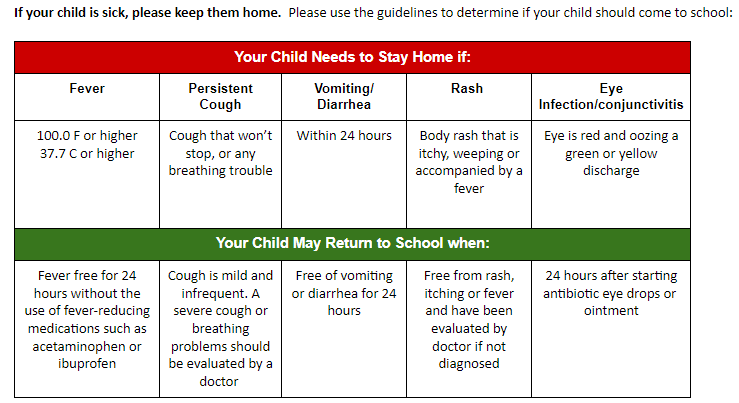When to Stay Home
Please report any contagious illness or condition to the school nurse. Your name will always remain confidential. Confidential Absence line/Save-A-Child Line: 781-979-2260 and press 1 for Attendance
Go To School or Stay Home?

Often when a child awakens with vague complaints (the way colds and flu begin) it is wise to observe your child at home for an hour or two before deciding whether or not to bring them to school. Your child should be physically able to participate in all school activities on return to school. Keeping a sick child at home will minimize the spread of infections and viruses in the classroom. Even in absence of symptoms in the chart above, please consider keeping your child at home for an extra day of rest and observation if they have any of the following symptoms:
Very stuffy or runny nose and/or cough
Mild sore throat (no fever, no known exposure to strep)
Headache
Stomach ache
Thank you in advance for your help in keeping our schools healthy!
Fever: 100 degrees or over. Must be fever free for 24 hours without the help of an over the counter fever reducer like Tylenol (acetaminophen) or Motrin (ibuprofen), even if fever free the next morning. Fevers can return or become higher by the afternoon or evening. Children also need a day to recover by resting and increasing their food and fluid intake. Seek out reliable babysitters who will care for your child when ill if you have to go to work.
If your child experiences covid-related symptoms*
Keep the child home
The child may return to school if/when:
Symptoms remain mild and the child has had a negative at-home COVID test OR
The child has been fever-free for 24 hours (without the use of fever-reducing medication) AND other symptoms are improving OR
A medical professional makes an alternative diagnosis
* A negative test is strongly recommended for return
* A second test within 48 hrs is recommended if the initial test is negative
*Covid Symptoms
If your child experiences Covid-related symptoms as below
Fever (100.0° F or higher), chills, or shaking chills
Difficulty breathing or shortness of breath
New loss of taste or smell
Muscle aches or body aches
Cough (not due to other known/diagnosed cause, such as chronic cough)
Sore throat, when in combination with other symptoms
Nausea, vomiting, when in combination with other symptoms
Headache, when in combination with other symptoms
Fatigue, when in combination with other symptoms
Nasal congestion or runny nose (not due to other known/diagnosed causes, such as allergies), when in combination with other symptoms
Keep them home. They may return to school: if/when
Fever (100 or more) a student returns to school when fever-free for 24 hours without using fever reducing medication such as Children's Tylenol or Motrin. An at home antigen COVID test is recommended, but not required. If the 1st test result is negative, a 2nd is recommended within 48 hours of the 1st.
Cough: a student can return to school when the cough is improved/milder--not frequent/continual. An At home antigen COVID test is recommended, but not required. If the 1st test result is negative, a 2nd is recommended within 48 hours of the 1st.
Vomiting or diarrhea: a student can return 24 hours after the last episode of either one
If your child tests (+) for covid?
They must isolate for 5 days from symptom onset or positive test date, whichever is earlier
They may return to school on Day 6 if symptoms are resolving, are fever-free for 24 hours without the use of fever-reducing medication and mask through Day 10
Masking is not required if they have a negative test on Day 5 or later
If unable to mask, they may return to school with a negative test on Day 5 or later
If your child is exposed to Covid-19:
They should wear a mask around others for 10 days (day zero is the last day of exposure) ADD what it is in parentheses
A test on Day 6 is recommended even if asymptomatic (ADD the word even)
If symptoms develop at any time during the 10 days, test and follow guidance based on the result
Cough/Cold: Keep home with a constant, audibly noisy, or productive cough, unless a child with asthma can control the cough with asthma medications.
Vomiting and Diarrhea: Student must be free of vomiting and diarrhea for 24 hours before returning to school. If they vomit or have diarrhea during the night, they should not return to school that morning. The symptoms often return.
Conjunctivitis: Red, itchy eye with thick yellow/green drainage or crustiness. Student may return 24 hours after antibiotic eye ointment begun. If no treatment ordered by doctor, must stay home until symptoms gone.
Strep Throat: May return 24 hours after antibiotics started, and 24 hours after fever gone. If left untreated a rash appears. See your doctor as soon as possible. This may indicate Scarlet fever.
Mononucleosis: Contagious by close contact. May return to school on the advice of the physician if temperature is below 100 F and able to tolerate activity. May need to start with half days.
Rash: Please see the doctor for any unexplained rash before sending them to school.
Chicken Pox: Highly contagious viral infection. May have less severe case or no infection if your child is up to date with their Varicella immunizations. Begins with a mild fever, itchy rash, malaise, headache, muscle aches, and chills. Rash starts as small red bumps that become blisters, ooze, then crust over. Students are contagious 1-2 days before the rash appears, and until all blisters have crusted over, or about 5-7 days after the rash first erupts. See you doctor. May not return until each lesion has scabbed over. Will be checked by the school nurse the first day back before goes to classroom.
Impetigo: Red or pink pustules with honey colored crusts, frequently on face around mouth. This is usually a staph infection, and can be contagious. Have PCP evaluate this. May return to school after 24 hours of therapy. Sores should be kept lightly covered until scabbed over/dried up completely.
Fifth Disease: Mild viral infection usually occurs in the late winter/spring. Red “slapped cheek” appearance on face, with “lacey” rash on trunk/arms/legs. By the time the rash appears, the child is not contagious. It can last for several weeks, and it is normal for it to look worse with heat, such as in baths or with exercise. Mild cold symptoms and fever may appear 3-7 days before the rash and is commonly mistaken for a cold. Adults with Fifth disease may also develop arthritis like symptoms of their joints, which can last for several months. Students can attend school with the rash.
When to Call the Doctor
Includes, but not exclusive to, the following list
Fever & vomiting at the same time.
Vomiting, with or without diarrhea lasting more than 24 hours.
Bloody diarrhea or diarrhea lasting several days.
A rash accompanied by a fever.
Any cold or cough that does not improve or grows worse after 7 days.
Ear pain, ear drainage or both.
Cuts that could require stitches.
Bleeding that can’t be stopped.
An inability to move an arm or leg.
Sharp unremitting pain in abdomen.
Poisoning
Burns
Convulsions
Difficulty breathing
Head injuries with loss of consciousness
Gray or ashen skin color
Blood in urine
Lack of energy or inability to move.
